Evaluation of Technical Condition and Durability of Wooden Shaft Guides with Application of Non-Destructive and Semi-Destructive Testing Methods
Abstract
1. Introduction
1.1. Wood Testing Methods
1.2. Characteristics of Wieliczka Salt Mine Shafts
2. Materials and Methods
Non-Destructive and Semi-Destructive Testing Methods
- fm—static flexural strength in three-point flexural test, MPa;
- l—distance between the supports, l = 900 mm;
- Fmax—maximum load (destructive force), N;
- W—section modulus, mm3.
3. Results
Traditional DT, NDT, and SDT Testing Methods
4. Discussion
5. Conclusions
Author Contributions
Funding
Institutional Review Board Statement
Informed Consent Statement
Data Availability Statement
Conflicts of Interest
References
- Zhao, J.; Ma, C.; Xiao, X.; Jiang, Y. Research on deformation law of guide rails caused by mine vertical shafts under non-mining action. Eng. Fail. Anal. 2022, 134, 106089. [Google Scholar] [CrossRef]
- Bajno, D.; Grzybowska, A.; Bednarz, Ł. Old and modern wooden buildings in the context of sustainable development. Energies 2021, 14, 5975. [Google Scholar] [CrossRef]
- Khan, M.M.; Krige, G.J. Evaluation of the structural integrity of aging mine shafts. Eng. Struct. 2002, 24, 901–907. [Google Scholar] [CrossRef]
- Nowogońska, B. Consequences of abandoning renovation: Case study—Neglected industrial heritage building. Sustainability 2020, 12, 6441. [Google Scholar] [CrossRef]
- Perria, E.; Sieder, M. Six-steps process of structural assessment of heritage timber structures: Definition based on the state of the art. Buildings 2020, 10, 109. [Google Scholar] [CrossRef]
- EN 17121 Conservation of Cultural Heritage. Historic Timber Structures. Guidelines for the on-Site Assessment of Load-Bearing Timber Structures; BSI: London, UK, 2020. [Google Scholar]
- Kasal, B.; Gretchen, L.; Tannert, T.; Sbartai, M.; Anthony, R.W.; Yamaguchi, N.; Riggio, M.; Piazza, M.; Macchioni, N.; Pignatelli, O.; et al. In Situ Assessment Of Structural Timber; Kasal, B., Tannert, T., Eds.; State of the Art Report of the RILEM Technical Committee 215-AST; Springer: Berlin, Germany, 2010; ISBN 9789400705593. [Google Scholar]
- Riggio, M.; D’Ayala, D.; Parisi, M.A.; Tardini, C. Assessment of heritage timber structures: Review of standards, guidelines and procedures. J. Cult. Herit. 2018, 31, 220–235. [Google Scholar] [CrossRef]
- Novosad, M.; Dandoš, R.; Černota, P.; Pospíšil, J. Surveying of old underground mining works using innovative measurement techniques. Arch. Min. Sci. 2019, 64, 739–746. [Google Scholar]
- Vala, D.; Seligova, D. (Eds.) Photogrammetry in Mining Shaft Inspection Using MCU Controled Led and Laser Light Source; IFAC: New York, NY, USA, 2013; Volume 12, ISBN 9783902823533. [Google Scholar]
- Machado, J.; Palma, P.; Simões, S. Ultrasonic indirect method for evaluating clear wood strength and stiffness. In Proceedings of the Nondestructive Testing in Civil Engineering, Nantes, France, 30 June–3 July 2009; pp. 3–8. [Google Scholar]
- Kaczmarczyk, G.P.; Kinasz, R.; Bilozir, V.; Bidenko, I. Application of X-ray computed tomography to verify bond failures mechanism of fiber—Reinforced Fine—grain concrete. Materials 2022, 15, 2193. [Google Scholar] [CrossRef]
- Dybeł, P.; Kucharska, M. X-ray CT investigation of bond mechanism in reinforced SCC elements of different placement technology. Materials 2021, 14, 6236. [Google Scholar] [CrossRef]
- Szade, A.; Szot, M.; Ramowski, A. Measurements of rope elongation or deflection in impact destructive testing. J. Sustain. Min. 2015, 14, 211–218. [Google Scholar] [CrossRef]
- Stasica, J. Modern methods of testing and evaluation of the technical state of mining shafts lining in Polish (Nowoczesne metody badań i oceny stanu technicznego obudów szybów górniczych). Zesz. Nauk. Inst. Gospod. Surowcami Miner. i Energią PAN 2017, 101, 85–99. [Google Scholar]
- Tannert, T.; Anthony, R.W.; Kasal, B.; Kloiber, M.; Piazza, M.; Riggio, M.; Rinn, F.; Widmann, R.; Yamaguchi, N. In situ assessment of structural timber using semi-destructive techniques. Mater. Struct. 2014, 47, 767–785. [Google Scholar] [CrossRef]
- Henriques, D.F.; Nunes, L.; Machado, J.S.; de Brito, J. Timber in buildings: Estimation of some properties using Pilodyn and Resistograph. In Proceedings of the International Conference on Durability of Building Materials and Components, Porto, Portugal, 12–15 April 2011; pp. 1–8. [Google Scholar]
- Kasal, B.; Drdacky, M.; Jirovsky, I. Semi-destructive methods for evaluation of timber structures. In Proceedings of the Structural Studies, Repairs and Maintenance of Heritage Architecture VIII, Halkidiki, Greece, 7–9 May 2003; WitPress: Southampton, UK, 2003; Volume 66, pp. 835–842. [Google Scholar]
- Kloiber, M.; Tippner, J.; Hrivnák, J. Mechanical properties of wood examined by semi-destructive devices. Mater. Struct. 2014, 47, 199–212. [Google Scholar] [CrossRef]
- Feio, A.; Machado, J.S. In-situ assessment of timber structural members: Combining information from visual strength grading and NDT/SDT methods—A review. Constr. Build. Mater. 2015, 101, 1157–1165. [Google Scholar] [CrossRef]
- Jaskowska-Lemańska, J.; Przesmycka, E. Semi-Destructive and Non-Destructive Tests of Timber Structure of Various Moisture Contents. Materials 2021, 14, 96. [Google Scholar] [CrossRef]
- Íñiguez-González, G.; Arriaga, F.; Esteban, M.; Llana, D.F. Reference conditions and modification factors for the standardization of nondestructive variables used in the evaluation of existing timber structures. Constr. Build. Mater. 2015, 101, 1166–1171. [Google Scholar] [CrossRef]
- Sandoz, J.L. Moisture content and temperature effect on ultrasound timber grading. Wood Sci. Technol. 1993, 27, 373–380. [Google Scholar] [CrossRef]
- Chang, L.; Qian, W.; Chang, H.; Chang, X.; Ye, T. Nondestructive testing based compressive bearing capacity prediction method for damaged wood components of ancient timber buildings. Materials 2021, 14, 5512. [Google Scholar] [CrossRef]
- de Oliveira, F.G.R.; Candian, M.; Lucchette, F.F.; Salgon, J.L.; Sales, A. A technical note on the relationship between ultrasonic velocity and moisture content of Brazilian hardwood (Goupia glabra). Build. Environ. 2005, 40, 297–300. [Google Scholar] [CrossRef]
- Lourenco, P.B.; Feio, A.O.; Machado, J.S. Chestnut wood in compression perpendicular to the grain: Non-destructive correlations for test results in new and old wood. Constr. Build. Mater. 2007, 21, 1617–1627. [Google Scholar] [CrossRef]
- Jaskowska-Lemańska, J.; Wałach, D. Impact of the direction of non-destructive test with respect to the annual growth rings of pine wood. Procedia Eng. 2016, 161, 925–930. [Google Scholar] [CrossRef][Green Version]
- Kimic, K.; Smaniotto Costa, C.; Negulescu, M. Creating tourism destinations of underground built heritage—The cases of salt mines in Poland, Portugal, and Romania. Sustainability 2021, 13, 9676. [Google Scholar] [CrossRef]
- Nowak, T.; Jasieńko, J.; Hamrol-Bielecka, K. In situ assessment of structural timber using the resistance drilling method—Evaluation of usefulness. Constr. Build. Mater. 2016, 102, 403–415. [Google Scholar] [CrossRef]
- Wałach, D.; Kaczmarczyk, G.P. Application of TLS remote sensing data in the analysis of the load-carrying capacity of structural steel elements. Remote Sens. 2021, 13, 2759. [Google Scholar] [CrossRef]
- Li, W.; Zou, S.; Yang, W.; Hu, Q. Model of heat and mass exchange between a downcast shaft and the air flow to the mine. Geofluids 2020, 2020, 8853839. [Google Scholar] [CrossRef]



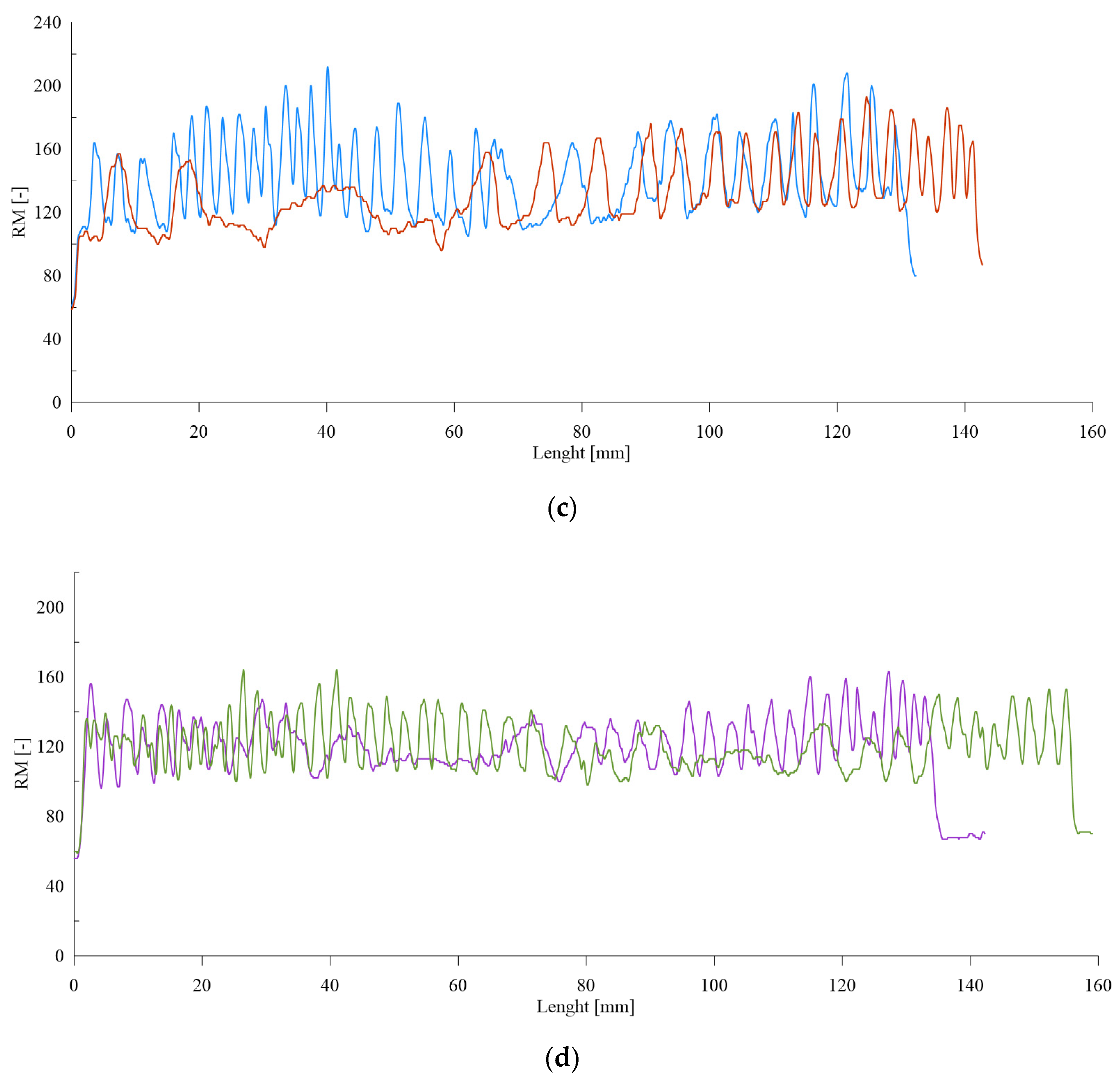
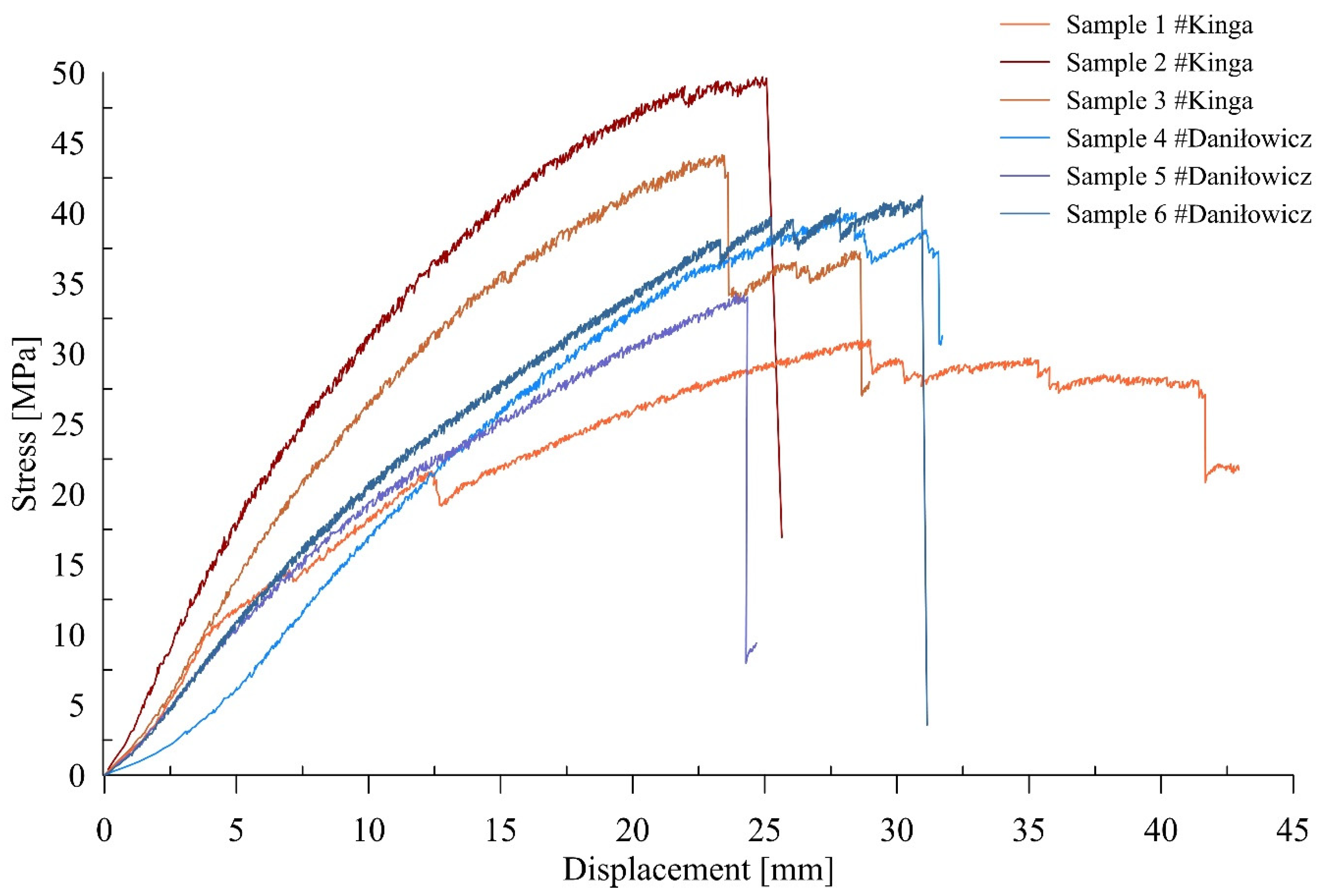


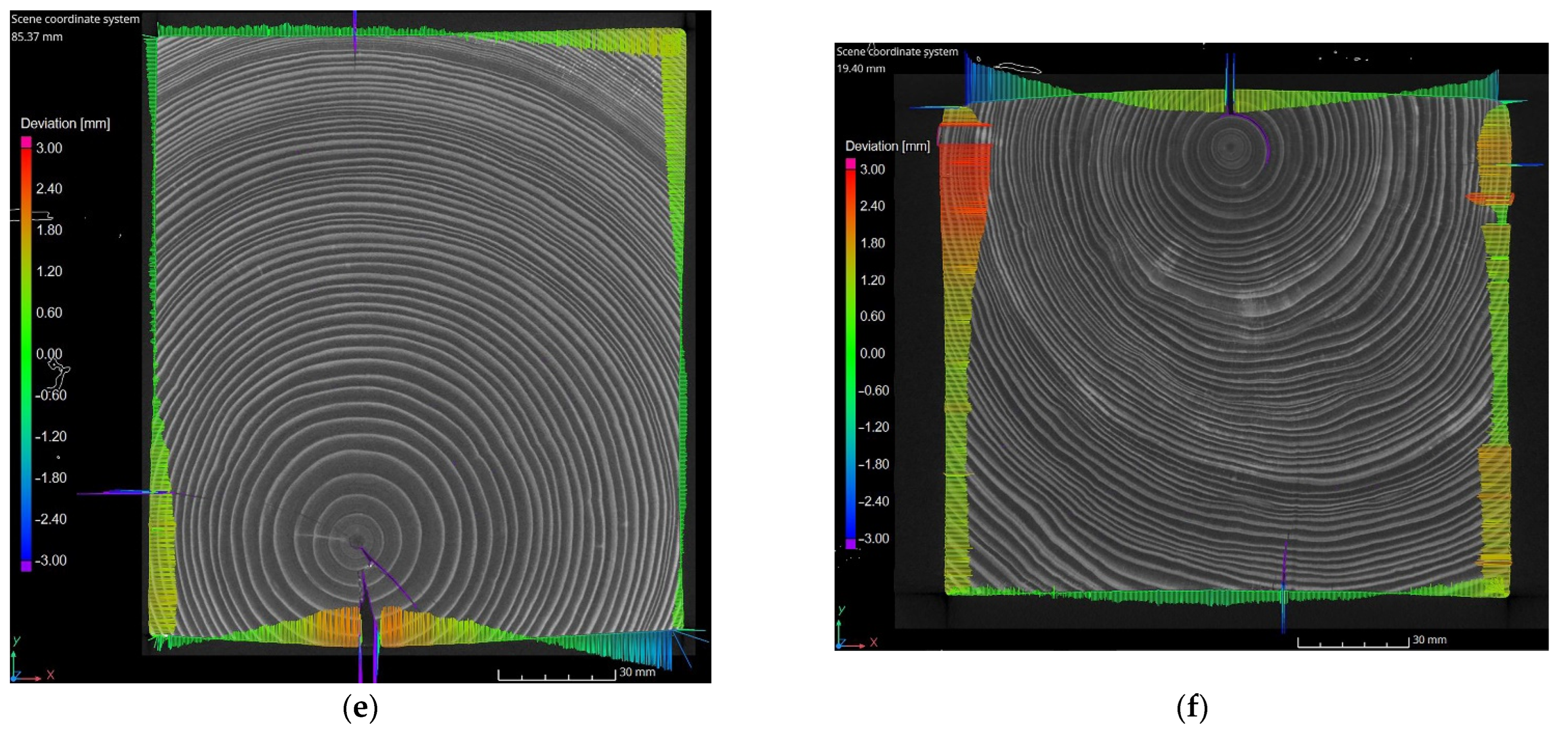
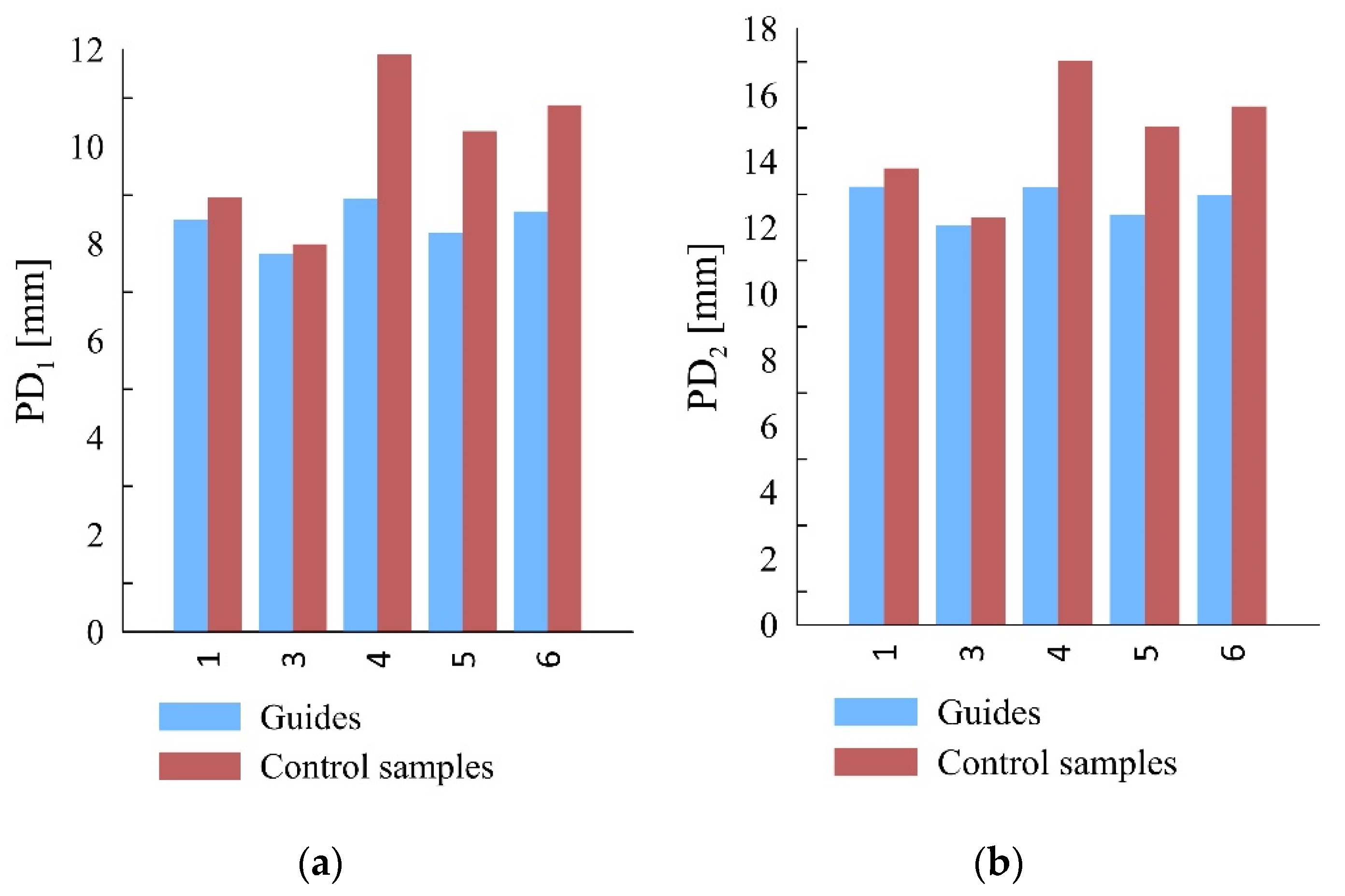
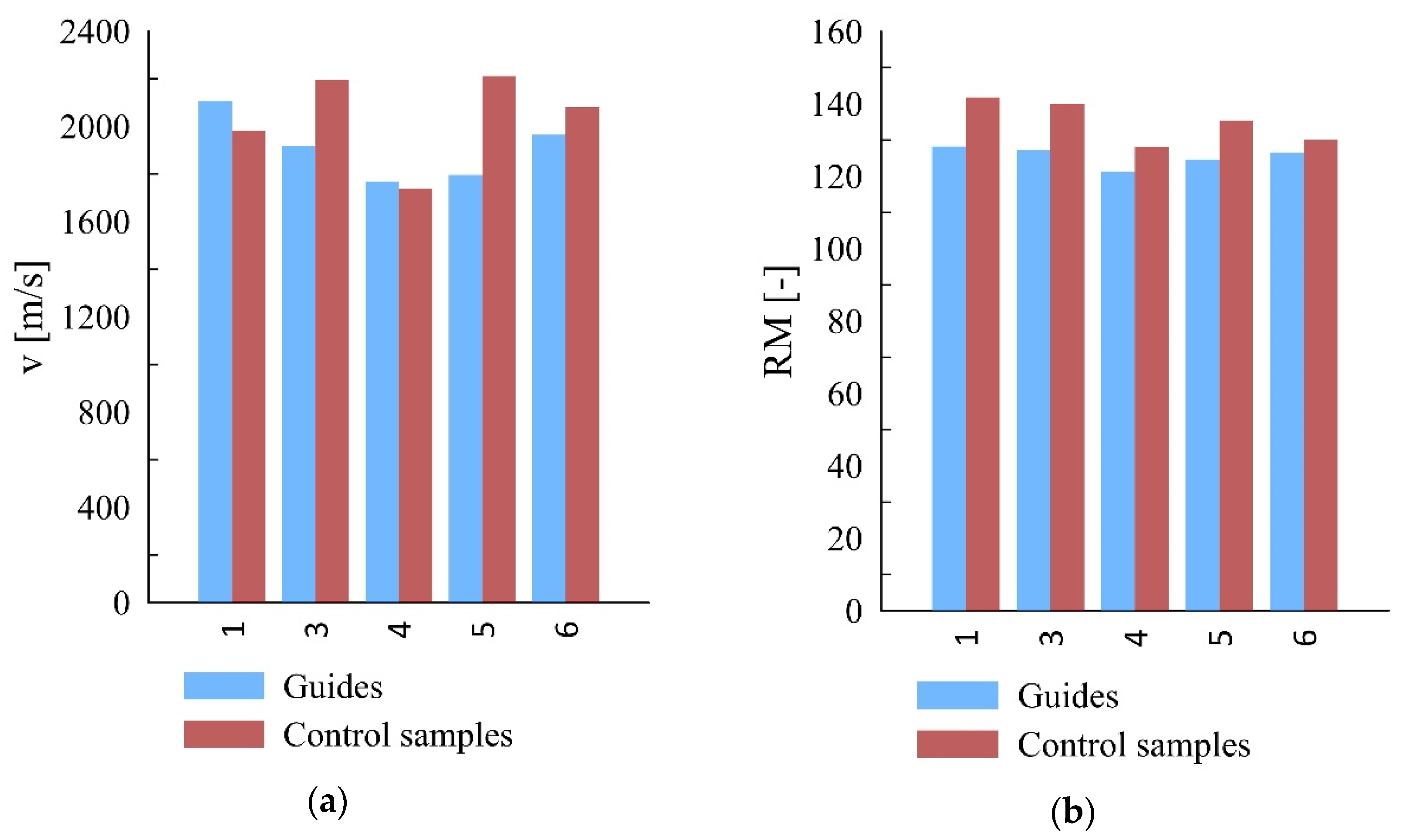

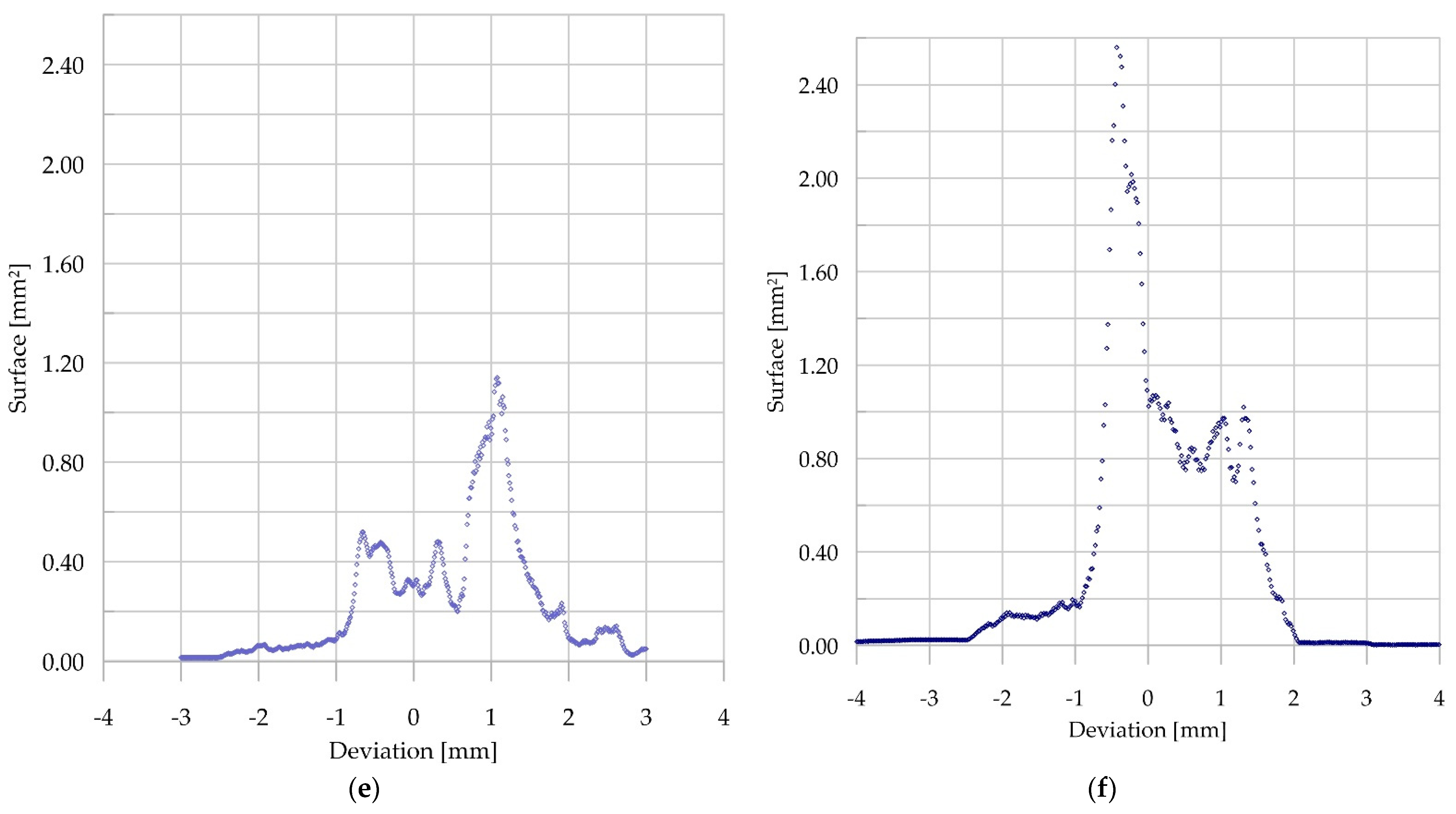
| Guide | Front Load [kN] | Side Load [kN] | |
|---|---|---|---|
| cage | west | 5.0 | 3.3 |
| east | 6.0 | 3.2 | |
| counterweight | west | 5.7 | 6.4 |
| east | 7.1 | 7.1 | |
| No. | Sample Origin | Sample Type and Age | Average Sample Cross-Section Dimensions [mm] | Average Sample Density in Air-Dry State [kg/m3] |
|---|---|---|---|---|
| 1 | #Kinga | solid, ~10 years | 128 × 139 | 489.6 |
| Ref 1 | reference | 125 × 125 | 491.1 | |
| 2 | #Kinga | laminated, ~5 years | 130 × 140 | 556.4 |
| 3 | #Kinga | solid, 15–20 years | 124 × 135 | 631.4 |
| Ref 3 | reference | 125 × 125 | 635.2 | |
| 4 | #Daniłowicz | solid (counterweight), ~10 years | 132 × 147 | 454.9 |
| Ref 4 | reference | 125 × 125 | 458.3 | |
| 5 | #Daniłowicz | solid (counterweight), ~2 years | 138 × 155 | 583.4 |
| Ref 5 | reference | 125 × 125 | 589.2 | |
| 6 | #Daniłowicz | solid (cage), ~5 years | 138 × 155 | 495.3 |
| Ref 6 | reference | 125 × 125 | 494.6 |
| No. | Nominal Dimension No. 1 [mm] | Nominal Dimension No. 2 [mm] | Age [Years] |
|---|---|---|---|
| 1 | 130 | 130 | 10 |
| 2 | 130 | 140 | 5 |
| 3 | 125 | 125 | 15–20 |
| 4 | 160 | 160 | 10 |
| 5 | 135 | 135 | 2 |
| 6 | 155 | 155 | 5 |
| No. | Cross-Section | Density [kg/m3] | PD1 [mm] | PD2 [mm] | v [m/s] | RM [-] | fm [MPa] |
|---|---|---|---|---|---|---|---|
| 1 | A-A | 489.6 | 8.43 | 13.29 | 2116.7 | 129.99 | 31.01 |
| B-B | 8.55 | 13.17 | 2095.8 | 126.56 | |||
| 2 | A-A | 556.4 | 9.99 | 14.97 | 2456.2 | 140.98 | 49.91 |
| B-B | 8.86 | 15.06 | 1827.3 | 131.28 | |||
| 3 | A-A | 631.4 | 7.54 | 11.71 | 1971.4 | 128.22 | 44.34 |
| B-B | 8.05 | 12.41 | 1863.3 | 126.21 | |||
| 4 | A-A | 454.9 | 8.96 | 13.28 | 1755.6 | 120.75 | 40.19 |
| B-B | 8.90 | 13.13 | 1780.3 | 122.37 | |||
| 5 | A-A | 583.4 | 8.58 | 12.57 | 1691.4 | 121.98 | 34.35 |
| B-B | 7.87 | 12.21 | 1899.8 | 127.28 | |||
| 6 | A-A | 495.3 | 8.18 | 12.74 | 1907.6 | 130.08 | 41.25 |
| B-B | 9.15 | 13.22 | 2021.9 | 122.94 |
| No. | Density [kg/m3] | PD1 [mm] | PD2 [mm] | v [m/s] | RM [-] | fm [MPa] |
|---|---|---|---|---|---|---|
| Ref 1 | 491.1 | 8.95 | 13.7850 | 1982.14 | 141.74 | 68.05 |
| Ref 2 | 635.2 | 7.99 | 12.3057 | 2195.99 | 139.99 | 88.12 |
| Ref 3 | 458.3 | 11.90 | 17.0322 | 1738.89 | 128.17 | 51.22 |
| Ref 4 | 589.2 | 10.32 | 15.0548 | 2211.37 | 135.351 | 74.14 |
| Ref 5 | 494.6 | 10.85 | 15.6519 | 2080.40 | 130.098 | 48.76 |
| Ref 6 | 491.1 | 8.95 | 13.7850 | 1982.14 | 141.74 | 68.05 |
Publisher’s Note: MDPI stays neutral with regard to jurisdictional claims in published maps and institutional affiliations. |
© 2022 by the authors. Licensee MDPI, Basel, Switzerland. This article is an open access article distributed under the terms and conditions of the Creative Commons Attribution (CC BY) license (https://creativecommons.org/licenses/by/4.0/).
Share and Cite
Pasek, R.; Jaskowska-Lemańska, J.; Wałach, D.; Rokita, T.; Kamiński, P. Evaluation of Technical Condition and Durability of Wooden Shaft Guides with Application of Non-Destructive and Semi-Destructive Testing Methods. Materials 2022, 15, 4769. https://doi.org/10.3390/ma15144769
Pasek R, Jaskowska-Lemańska J, Wałach D, Rokita T, Kamiński P. Evaluation of Technical Condition and Durability of Wooden Shaft Guides with Application of Non-Destructive and Semi-Destructive Testing Methods. Materials. 2022; 15(14):4769. https://doi.org/10.3390/ma15144769
Chicago/Turabian StylePasek, Rafał, Justyna Jaskowska-Lemańska, Daniel Wałach, Tomasz Rokita, and Paweł Kamiński. 2022. "Evaluation of Technical Condition and Durability of Wooden Shaft Guides with Application of Non-Destructive and Semi-Destructive Testing Methods" Materials 15, no. 14: 4769. https://doi.org/10.3390/ma15144769
APA StylePasek, R., Jaskowska-Lemańska, J., Wałach, D., Rokita, T., & Kamiński, P. (2022). Evaluation of Technical Condition and Durability of Wooden Shaft Guides with Application of Non-Destructive and Semi-Destructive Testing Methods. Materials, 15(14), 4769. https://doi.org/10.3390/ma15144769









